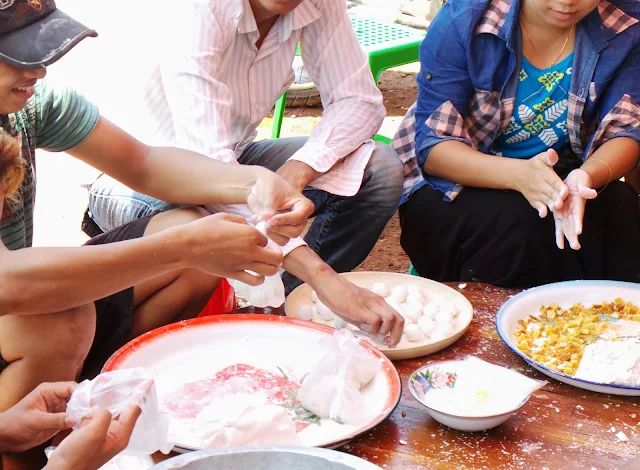Thingyan, the Burmese New Year which is celebrated over four to five days in April each year is associated with two things - the water festival and eating mont lone yay baw မုန့်လုံးရေပေါ် (glutinous rice ball).
During Thingyan, Burmese splash and douse each other with water. There is a lot of playfulness and fun in the spirit of celebrating the new year.
The water washes away sins and bad luck of the past year, so it is a blessing to be splashed and cleansed with water.
 |
| Ganesha in a street shrine in Yangon, Myanmar |
The legend of Thingyan is about a bet between Arsi အာသီ (king of Brahmas) and Sakra သိကြားမင် (king of Devas). Arsi lost the bet and was beheaded by Sakra.
 |
| Ganesha from the Mrauk U kingdom (1430 - 1785) in Rakhine state in Myanmar |
An elephant head was installed on Arsi's body and he became Ganesha.
Arsi's decapitated head cannot be thrown into the sea as it will dry up the oceans. If thrown on land, there will be drought. Throwing Arsi's head in the air will set the sky on fire.
Sakra hence ordered the goddesses to take turns carrying Arsi's head, each for one year. The New Year or Thingyan is the time Arsi's head is passed from one goddess to the next.
Thingyan, in Sanskrit means "transition" and it marks the movement of the sun from Pisces to Aries constellation. Thingyan also marks the end of the hot season in Myanmar.
The glutinous rice ball is traditionally associated with the Burmese New Year. Burmese come together during Thingyan to make and enjoy mont lone yay baw မုန့်လုံးရေပေါ် (also spelt mont lone yay paw). During Thingyan, mont lone yay baw are also made in public places and distributed as gifts to revellers and passers-by in a custom known as satuditha စတုဒိသာ.
Mont lone yay baw literally means "snack balls floating in water".
Mont-lone-yay-paw are made with glutinous rice flour and water, kneaded into dough which are then divided into smaller pieces. These are stuffed with a piece of jaggery each and then hand rolled into balls which are cooked by boiling in water. The sweet glutinous rice balls float when cooked, hence the name"snack balls floating in water". Mont-lone-yay-paw are served garnished with grated coconut pulp.
Mont-lone-yay-paw is very similar to the Indonesian klepon, Malaysian onde onde and Chinese tang yuan. So, how did mont-lone-yay-paw come about in Myanmar and how did it get closely associated with Thingyan? I am still looking for answers to these questions.
Reference:



-EDIT.jpg)
No comments:
Post a Comment
All comments submitted with genuine identities are published